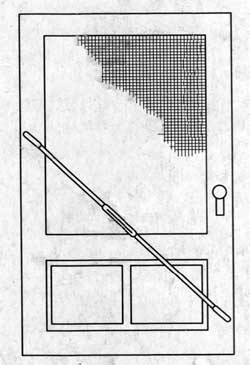Small Home Gazette, Spring 2012
Screen Door Blues
About 10 years ago we happily replaced the aluminum screen door on our back entrance with a new wood version with glass and screen inserts. We were advised to paint it rather than stain it. Last summer the door warped—bowing out about an inch at the top and bottom corners on the latch side. We were dumbfounded as to why the door would warp after so many years. And we didn’t know how to fix it.
After doing some research, a man from a local door company suggested we try a simple, if inelegant, solution before investing in another door.
 Metal rods with a turnbuckle in the center were often used to square up an old time screen door that had sagged out of square. You might remember seeing this rod system on the door of a cabin or a screen porch.
Metal rods with a turnbuckle in the center were often used to square up an old time screen door that had sagged out of square. You might remember seeing this rod system on the door of a cabin or a screen porch.
We used two sets of rods; mounted one end near the center hinge; and extended the other toward the opposite corners that had bowed outward. We wedged a small, shallow block of wood between the rods and the door so we could tighten the turnbuckle without too much damage to the wood. The corners have pulled inward but we have not entirely eliminated the warp.
The mystery remained of why it had taken 10 years for the door to warp. We turned to a wood chemist friend. He was equally baffled until we explained that this is a south-facing door with no protection from rain, snow or sun, and that the previous fall we removed a large maple tree that had shaded the door for most of the day. We also had left the glass insert installed for most of the summer following the tree removal.
Our wood chemist explained how much drier and hotter it was for our wood door without the shade from the tree. This change in conditions coupled with last summer’s high heat and humidity “shocked” the door. Leaving the glass in made matters worse by heating the door from both sides—warm sunlight on the outside and a “solar oven” on the inside (between the screen door and the inner door).
He is skeptical about whether our metal rods will ever eliminate the warp. He suggests either a metal or fiberglass screen door, either of which can better handle the extremes of temperature and moisture at our back door. Because of our earlier research, we know new doors made of these materials come in standard sizes that are not an easy fit for our narrow doorframe plus the look isn’t what we want. If we decide to replace the door, we will prowl through salvage yards or purchase another new wood door. In the meantime, the metal rod system has helped; we’ve planted a replacement shade tree; and, you know, the rods looks just fine on a screen door on a bungalow.











